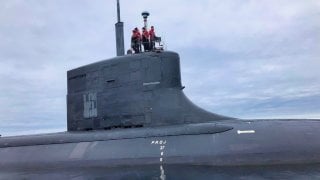A Seawolf Attack Submarine Slammed Into an 'Underwater Seamount' at High Speed
On October 2021, the U.S. Navy's Seawolf-class submarine USS Connecticut collided with an underwater seamount in the South China Sea while traveling at high speed in poorly charted waters. The collision injured eleven sailors and raised questions about how such an advanced vessel could strike an underwater mountain.
What You Need to Know: On October 2021, the U.S. Navy's Seawolf-class submarine USS Connecticut collided with an underwater seamount in the South China Sea while traveling at high speed in poorly charted waters. The collision injured eleven sailors and raised questions about how such an advanced vessel could strike an underwater mountain.

-An official Navy report attributed the incident to navigational planning errors and failures in watch team execution and risk management.
-Some analysts have speculated that a massive whirlpool observed in the area might have contributed, but this theory remains unconfirmed. The USS Connecticut is undergoing repairs and is expected to return to service in 2025.
USS Connecticut Collision: How Did a U.S. Submarine Hit an Underwater Mountain?
More than three years have passed since the USS Connecticut (SSN-22) collided with an underwater seamount - or what some call an underwater mountain - in the South China Sea, and experts are still debating the cause of the incident.
On October 2, 2021, the U.S. Navy’s Seawolf-class submarine grounded on the seamount while traveling high speed in poorly charted waters.
As a result of the collision, eleven sailors were injured. However, Rear Admiral Christopher Cavanaugh, who led the investigation into the grounding at the time, disclosed that “A grounding at this speed and depth had the potential for more serious injuries, fatalities, and even loss of the ship.”
So, what caused the collision? New details might be emerging that could change all of our perspectives on the issue.
An Overview of USS Connecticut:
As a Seawolf-class nuclear-powered fast attack submarine, USS Connecticut is widely considered to be one of the most advanced vessels of her kind. Able to run silent and run deep, the $3.5 billion submarine remains a critical component of the Navy’s deterrent strategy.
Like her sister ships, Connecticut carries some of the most sophisticated undersea warfare technology ever developed. Armament-wise, these ships can pack a punch. They feature 533mm Mark 48 torpedoes, in addition to Tomahawk cruise missiles and Harpoon anti-ship missiles.
Considering these powerful and costly weapons positioned onboard the submarines, any underwater collision involving a Seawolf is severely detrimental to the service.
How did the Submarine Hit an Underwater Mountain?
According to the official report released following the incident, the collision "resulted from an accumulation of errors and omissions in navigation planning, watchteam execution, and risk management that fell far below U.S. Navy standards … Prudent decision-making and adherence to required procedures in any of these three areas could have prevented the grounding." News outlet Stars and Stripes also noted that prior to the crash, “At least one sailor detected sonar readings that were not matching the navigational chart of the undersea area. However, the officer of the deck did not report the hazard to the Connecticut’s commanding officer, who was not standing duty at the time.”
What About the Whirlpool Theory?
Some analysts have questioned whether a massive whirlpool discovered around the time of the collision could be to blame.
In September 2021, Chinese researchers recorded an enormous whirlpool in the South China Sea. The whirlpool tracked by Beijing’s scientists could have lasted into October when the crash occurred, since such phenomena can reportedly last for weeks to months at a time.
While this theory has not been confirmed or denied, it perhaps remains a plausible explanation for the USS Connecticut grounding. Ultimately, the Navy has disclosed that the Connecticut collision was indeed preventable.
Over the last couple of years, the service has prioritized training and certification in an effort to prevent similar incidents from happening in the future. As tensions between Washington and Beijing only escalate in these waters, it is essential that the Navy’s top-tier submarines are functioning.
Since the collision, Connecticut has been undergoing a repair overhaul. The Seawolf-class submarine is expected to return to service sometime in 2025.
About the Author: Maya Carlin, Defense Expert
Maya Carlin, National Security Writer with The National Interest, is an analyst with the Center for Security Policy and a former Anna Sobol Levy Fellow at IDC Herzliya in Israel. She has by-lines in many publications, including The National Interest, Jerusalem Post, and Times of Israel. You can follow her on Twitter: @MayaCarlin.
Image Credit: Creative Commons and/or Shutterstock.


